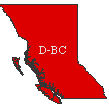HagridOfTheDeep
Junior Chimp
    
Posts: 8,763

Political Matrix
E: -6.19, S: -4.35
|
 |
« on: March 26, 2016, 12:57:36 AM » |
|
|
« edited: March 26, 2016, 01:00:20 AM by HagridOfTheDeep »
|
Former Canadians are completely polarized over their inclusion in the United States. Canadian nationalists immediately establish a Free Canada Party, which aims to run candidates for state and federal offices in the former provinces of Canada. This party does not contest presidential races.
Meanwhile, in la belle province, Quebec sovereigntists are in an even bigger uproar than usual because the United States refuses to recognize the Quebec nation or French as an official language. Quebecers, particularly Francophones, coalesce en mass around the Bloc Quebecois at the federal level and the Parti Quebecois at the state level. Even Quebecers who never associated themselves with the sovereigntist movement are compelled to join the ranks of these parties. Neither party decides to run a presidential candidate, however, as they realize this candidate would only be successful with Quebec's electoral votes.
Still, some Canadians are complacent about these changes or believe they won't be reversed, so decide to engage with the political system ideologically. The Liberal and Conservative parties quickly die, as these former Canadians want their votes to actually matter. For those who choose to accept their place in the new mega-country, the Democratic Party becomes the clear choice; Republicans find very little support in the former provinces, save for a sizeable minority in Alberta.
Not all Canadians are satisfied with choosing between the Free Canada Party, the Quebec sovereigntist parties, the Democrats, and the Republicans, however. As such, the New Democratic Party manages to weather the storm of Canada's absorption into the United States. The NDP has decent success in the ten former provinces and three former territories of Canada. Interestingly, NDP party leaders see a demand for their ideological brand in the original 50 states too, so they decide to expand and contest races throughout all 63 states.
So what does this mean for how government looks?
The Free Canada party wins the governorships of almost all of the 13 new states, with a few exceptions. Quebec overwhelmingly elects a governor from the Parti Quebecois. Ontario elects a Democratic governor while British Columbia elects a New Democrat.
In the House of Representatives, the Canadian caucus is divided as follows: 55% for the Free Canada Party, 10% for the Bloc Quebecois, 20% for the Democratic Party, 10% for the New Democratic Party, and 5% for the Republicans. In the original 50 states, the House is divided as follows: 65% Republican, 35% Democrat, 10% New Democrat. The NDP mostly served as a spoiler that handed a lot of races to the GOP.
Things shake up similarly in the senate, except here the Free Canada Party and the Bloc Quebecois have extremely outsized influence. The only NDP senators come from Quebec and Vermont.
Presidentially, the presence of the New Democratic Party is a spoiler in some places throughout the original 50 states, but the deep unpopularity of the Republican brand in the new 13 states means that the Democrats have a solid hold on these areas, which means it's kind of a wash (or possibly gives an advantage to the Democrats). That being said, the NDP does occasionally manage to break through in some places like British Columbia, Vermont, and Quebec in the odd presidential race.
As time goes on, the Canadian nationalist movements lose steam. A lot of these folks would have been Conservative voters, so a decent share of them goes to the GOP. Still, most make their way to the NDP or the Democratic Party.
|

